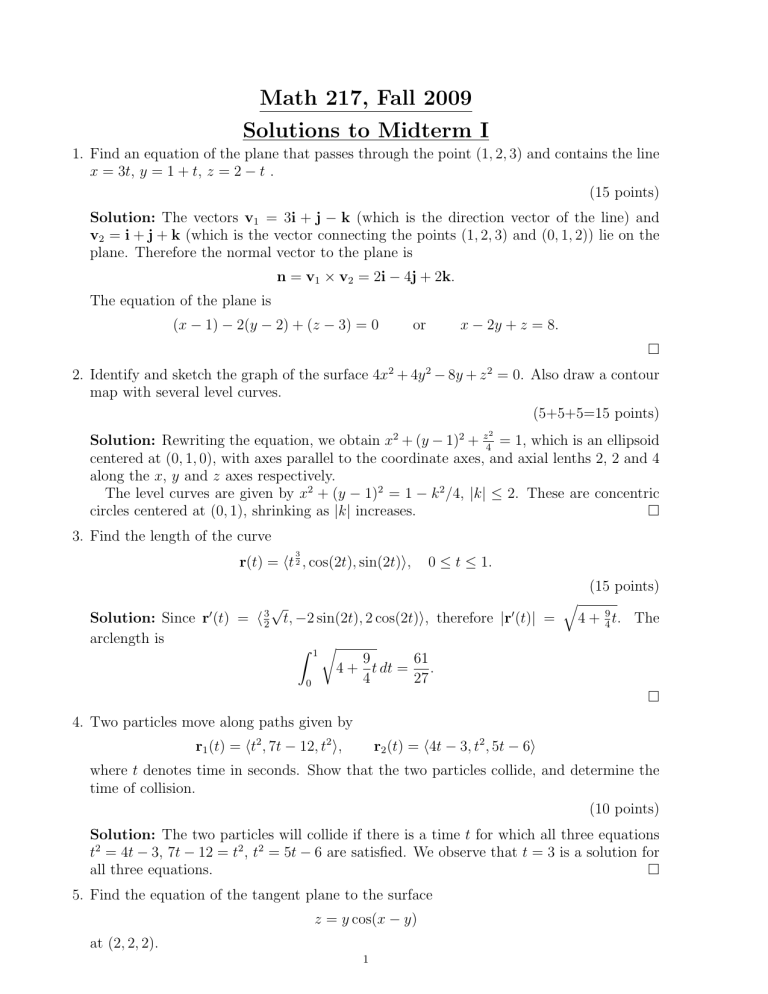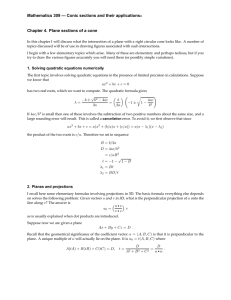Math 217, Fall 2009 Solutions to Midterm I

Math 217, Fall 2009
Solutions to Midterm I
1. Find an equation of the plane that passes through the point (1 , 2 , 3) and contains the line x = 3 t , y = 1 + t , z = 2 − t .
(15 points)
Solution: The vectors v
1
= 3 i + j − k (which is the direction vector of the line) and v
2
= i + j + k (which is the vector connecting the points (1 , 2 , 3) and (0 , 1 , 2)) lie on the plane. Therefore the normal vector to the plane is n = v
1
× v
2
= 2 i − 4 j + 2 k .
The equation of the plane is
( x − 1) − 2( y − 2) + ( z − 3) = 0 or x − 2 y + z = 8 .
2. Identify and sketch the graph of the surface 4 x
2
+ 4 y
2 − 8 y + z
2 map with several level curves.
= 0. Also draw a contour
(5+5+5=15 points)
Solution: Rewriting the equation, we obtain x 2 + ( y − 1) 2 + z
2
= 1, which is an ellipsoid
4 centered at (0 , 1 , 0), with axes parallel to the coordinate axes, and axial lenths 2, 2 and 4 along the x , y and z axes respectively.
The level curves are given by x 2 + ( y − 1) 2 = 1 − k 2 / 4, | k | ≤ 2. These are concentric circles centered at (0 , 1), shrinking as | k | increases.
3. Find the length of the curve r ( t ) = h t
3
2
, cos(2 t ) , sin(2 t ) i , 0 ≤ t ≤ 1 .
(15 points)
Solution: Since r
0
( t ) = h 3
2
√ t, − 2 sin(2 t ) , 2 cos(2 t ) i , therefore | r
0
( t ) | = arclength is r
Z
1
0
4 +
9
4 t dt =
61
27
.
q
4 +
9
4 t . The
4. Two particles move along paths given by r
1
( t ) = h t
2
, 7 t − 12 , t
2 i , r
2
( t ) = h 4 t − 3 , t
2
, 5 t − 6 i where t denotes time in seconds. Show that the two particles collide, and determine the time of collision.
(10 points)
Solution: The two particles will collide if there is a time t for which all three equations t 2 = 4 t − 3, 7 t − 12 = t 2 , t 2 = 5 t − 6 are satisfied. We observe that t = 3 is a solution for all three equations.
5. Find the equation of the tangent plane to the surface z = y cos( x − y ) at (2 , 2 , 2).
1
Solution: We compute at (2 , 2 , 2)
∂z
∂x
= − y sin( x − y ) = 0 ,
The equation of the tangent plane is
∂z
∂y
= cos( x − y ) + y sin( x − y ) = 1 .
z − 2 = 0( x − 2) + 1( y − 2) or z = y.
(15 points)
6. The radius of a right circular cone is increasing at the rate of 1 in/s while its height is decreasing at a rate of 2 in/s. At what rate is the volume of the cone changing when the radius is 10 in and the height is 5 in.? (Hint: Recall that the volume of a right circular cone is π
3 times the square of the radius times the height.)
(15 points)
Solution: Since V =
1
3
πr 2 h , we obtain by differentiating with respect to t , dV dt
=
π
3
2 r dr dt h + r
2 dh dt
=
π
3
((20)(1)(5) − (100)(2)) = −
100 π
3 in
3
/ s .
7. Determine whether the following limit exists. If yes, evaluate the limit. If the limit does not exist, explain why.
lim
( x,y ) → (0 , 0) x
2
+ sin
2
2 x 2 + y 2 y
.
Solution: Choose a linear path of the form y = mx converging to (0 , 0). Then x
2
+ sin
2 y
2 x 2 + y 2
= x
2
+ sin
2
( mx )
2 x 2 + ( mx ) 2
=
1 + sin
2
( mx ) x 2
2 + m 2
.
Since lim x → 0 sin( mx ) /x = m by L’Hopital’s rule, we obtain lim x → 0
1 + sin
2
( mx ) x 2
2 + m 2
=
1 + m
2
2 + m 2
, which depends on m . Thus the limit does not exist.
2






